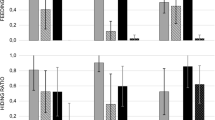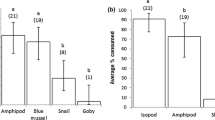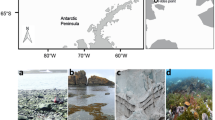Abstract
Large invasive predators like the king crab, Paralithodes camtschaticus, deserve particular attention due to their potential for catastrophic ecological impact on recipient communities. Conspicuous, epibenthic prey species, such as the slow growing commercial scallop Chlamys islandica, are particularly exposed to the risk of local extinction. A research program integrating experiments and field monitoring is attempting to predict and track the impact of invasive king crab on scallop beds and associated fauna along the north Norwegian coast. The claw gape of the crab shows no limitations in handling the flat-bodied scallop. However, the potential impact of the crab on scallop may depend on the availability of other calcified prey associated with scallop beds, such as the sea star, sea urchin, and blue mussel, all species recorded in the diet of P. camtschaticus. To address this issue, a laboratory experiment on foraging behaviour of P. camtschaticus was conducted. The experimental results show that all size classes of red king crab prefer scallops, but small juveniles and medium sized crabs demonstrate active selection for starfish (Asterias rubens) that equals or surpasses the electivity of the large crab. The selection of sea urchin (Strongylocentrotus droebachiensis) and blue mussel (Mytilus edulis) is slightly positive or neutral for the three crab size classes. These results suggest that scallop beds with a rich associated fauna are less vulnerable to red king crabs predation and possibly more resilient than beds with few associated species. Also, crab size distribution is likely relevant for invasion impact, with increasing abundance of small and medium sized crabs being detrimental for alternative calcified prey associated with scallop beds. Successive stages of crab invasion will see an acceleration of scallop mortality rates associated with (i) decreasing availability of alternative prey, due to protracted predation pressure intensified by recruitment of juvenile crabs, and (ii) increased number of large crabs. Estimates of crab density and intake rates suggest that the accelerated loss rates will eventually endanger scallop beds persistence.




Similar content being viewed by others
References
Anisimova, N., A. M. Hjelset, I. E. Manushin, M. A. Pinchukov & J. Sundet, 2004. Joint report for 2004 on the red king crab (Paralithodes camtchaticus) investigations in the Barents Sea. Report on the 33nd Session of the Joint Russian-Norwegian Fisheries Commission. 26 pp.
Arsenault, D. J. & J. H. Himmelman, 1996. Size-related changes in vulnerability to predators and spatial refuge use by juvenile Iceland scallop Chlamys islandica. Marine Ecology Progress Series 140: 115–122.
Arsenault, D. J. & J. H. Himmelman, 1998. Size-related decrease refuge use by Iceland scallops Chlamys islandica: ontogenetic behavioural change or decreasing refuge availability? Marine Ecology Progress Series 162: 153–161.
Barbeau, M. A., R. E. Scheibling & B. G. Hatcher, 1998. Behavioural responses of predatory crabs and sea stars to varying density of juvenile sea scallops. Aquaculture 169: 87–98.
Burch, A. & S. Raymond, 2000. Foraging behaviour of Carcinus maenas on Mytilus edulis: the importance of prey presentation. Journal of Marine Biological Association U.K. 80: 799–810.
Cunningham, D. T., 1969. A study of the food and feeding relationships of the Alaskan king crab Paralithodes camtschatica. Master’s thesis. San Diego State College, California, 84 pp.
Gerasimova, O. V., 1997. Analysis of king crab (Paralithodes camtschatica) trophic links in the Barents Sea. ICES CM 1977/GG:03: 21 pp.
Gudimov, A. V., E. N. Gudimova & L. V. Pavlova, 2003. Effect of the Red King Crab Paralithodes camtschaticus on the Murmansk Coastal Macrobenthos: The first estimates using sea urchins of the genus Strongylocentrotus as an example. Doklady Biological Sciences 398: 539–541.
Grosholz, E. D., G. M. Ruiz, C. A. Dean, K. A. Shirley, J. L. Maron & P. G. Connors, 2000. The impacts of a non-indigenous marine predator in a California Bay. Ecology 81: 1206–1224.
Heiman, K., 2005. Strongly interacting nonindigenous species. Bioscience 55: 548.
Huston, M. A., 1979. A general hypothesis of species diversity. American Naturalist 113: 81–101.
Jewett, S. C. & H. M. Feder, 1982. Food and feeding habits of the king crab Paralithodes camtschatica near Kodiak Island, Alaska. Marine Biology 66: 243–250.
Jewett, S. C., L. A. Gardner & P. M. Rusanowski, 1989. Food and feeding habits of red king crab from north-western Norton Sound Alaska pp. 219–232, In: Proceedings of the International Symposium of King Tanner crabs, University of Alaska Sea Grant Rep., 90–04.
Jørgensen, L. L., 2006. Impact scenario for an introduced decapod on Arctic epibenthic communities. Biological Invasion (accepted for publication 21.09.2004).
Manly, B. F. J., L. L. McDonald, D. L. Thomas, T. L. McDonald & W. P. Erikson, 2002. Resource selection by animals. Statistical design and analysis for field studies. 2nd ed. Kluwer Academic Publishers, 240 p.
Murray, J. D., 2002. Mathematical biology I. An introduction 3rd ed. Springer-Verlag, Berlin, 551 p.
Murdoch, W. W. & A. Oaten, 1975. Predation and population stability. Advances in Ecological Research 9: 1–131.
Orlov, Y. I. & B. G. Ivanov, 1978. On the introduction of the Kamchatka king crab Paralithodes camtschatica (Decapoda: Anomura: Lithodidae) into the Barents Sea. Marine Biology 48: 373–375.
Pedersen, O. P., E. M. Nilssen, L. L. Jørgensen & D. Slagstad, 2006. Advection of the red king crab larvae on the coast of North Norway—A Lagrangian model study. Fisheries research 79: 325–336.
Powell, G. C. & R. B. Nickerson, 1965. Reproduction of king crabs Paralithodes camtschatica (Tilesius). Journal Fisheries Research Board of Canada 22: 101–111.
Pyke, G. H., H. R. Pulliam & E. L. Charnov, 1977. Optimal foraging: a selective review of theory and tests. Quarterly Review of Biology 52: 137–154.
Rauscher, M. D., 1978. Search image for leaf shape in a butterfly. Science 200: 1071–1073.
Soule, M. E., J. A. Ester, B. Miller & D. L. Honnold, 2005. Strongly interacting species: conservation policy, management, and ethics. Bioscience 55: 168–176.
Stephens, D. W. & J. R. Krebs, 1986. Foraging theory. Princeton University Press, Princeton, New Jersey, 262 p.
Sundet, J. H., 1999. Bifangst av kongekrabbe i garn- og linefisket i 1998. [Bycatch of king crab in gillnet and line fishery in 1998]. Fiskeriforskning, Rapport. 2/1999. Tromsoe, Norway 20 pp [In Norwegian].
Sundet, J. H., E. E. Rafter & E. M. Nilssen, 2000. Stomach content of the red king crab (Paralithodes camtchaticus) (Tilesius, 1815) in the Southern Barents Sea. Crustacean issues 12. The biodiversity crisis and Crustacea. Proceedings of the forth international crustacean congress, Amsterdam, Netherlands, 20–24 July 1998, Vol. 2. 193–201.
Vahl, O., 1981. Energy transformation by the Iceland scallop, Chlamys islandica (O. F. Müller), from 70°N. I: the age-specific energy budget and net growth efficiency. Journal of Experimental Marin Biology and Ecology. 53: 281–296.
Wallace, M. M., C. J. Pertuit & A. R. Hvatum, 1949. Contribution to the biology of the king crab, Paralithodes camtschatica (Tilesius). U.S. Department of International Fisheries and Wildlife Services. Fish Leaflet 340: 50.
Walton, W. C., C. MacKinnon, L. F. Rodriguez, C. Proctor & G. M. Ruiz, 2002. Effect of an invasive crab upon a marine fishery: green crab, Carcinus maenas, predation upon a venerid clam, Katelysia scalarina, in Tasmania (Australia). Journal of Experimental Marine Biology and Ecology 272: 171–189.
Weber, D. D., 1967. Growth of the immature king crab, Paralithodes camtschatica (Tilesius). International North Pacific Fishery Community Bulletin 21: 21–53.
Wiborg, K. F., 1962. Some observations on the Iceland scallop Chlamys islandica (Müller) in Norwegian waters. Fiskeridirektoratets skrifter (serie Havundersøkelser) 13: 38–53.
Woodward, G., B. Ebenman, M. Emmerson, J. M. Montoya, J. M. Olesen, A. Valido & P. H. Warren, 2005. Body size in ecological networks. TREE 20: 402–409.
Zhou, S., T. C. Shirley & G. H. Kruse, 1998. Feeding and growth of the red king crab Paralithodes camtschaticus under laboratory conditions. Journal of Crustacean Biology 18: 337–345.
Acknowledgements
This research was financed by the Norwegian Research Council (Projectno: 140295/120). We thank Einar M. Nilssen (Norwegian College of Fishery Science, University of Tromsoe), Jan Sundet (Institute of Marine Research), and Paul Clark (The Natural History Museum, London) for helpful discussions and suggestions. We also thank the organisers Paul Clark and Liz Cook of the Invasive Crustacea “Sixth International Crustacean Congress” Glasgow 2005, for showing interests for this project. Thanks also to Paul Clark for editing the language. Thank to three anonymous referees for useful and thoroughly comments. Thanks to the directorate of Norwegian College of Fishery Science and the Institute of Marine Research for showing interest in this project, and the crew on our R/V “Hyas” and “Johan Ruud” for collecting material.
Author information
Authors and Affiliations
Corresponding author
Rights and permissions
About this article
Cite this article
Jørgensen, L.L., Primicerio, R. Impact scenario for the invasive red king crab Paralithodes camtschaticus (Tilesius, 1815) (Reptantia, Lithodidae) on Norwegian, native, epibenthic prey. Hydrobiologia 590, 47–54 (2007). https://doi.org/10.1007/s10750-007-0756-9
Issue Date:
DOI: https://doi.org/10.1007/s10750-007-0756-9




